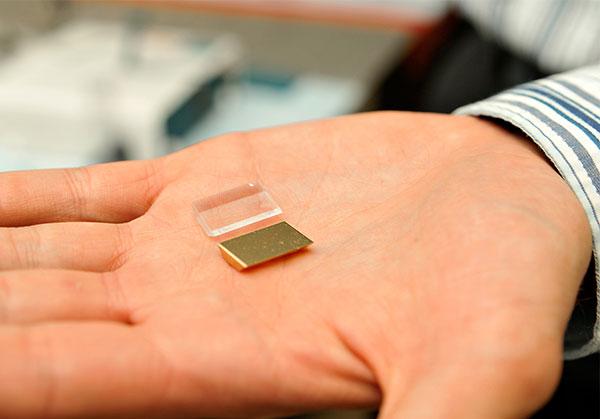New nanodevice to improve cancer treatment monitoring

The gold nanonparticules on the surface of this receiving tab modify the colour of light detected by the instrument. The captured colour perfectly reflects the exact concentration of the medication in the blood sample. Les nanoparticules d'or situées à la surface de la languette réceptrice modifient la couleur de la lumière détectée par l'instrument. La couleur captée reflète la concentration exacte du médicament contenu dans l'échantillon sanguin. Credit: University of Montreal
Methotrexate has been used for many years to treat certain cancers, among other diseases, because of its ability to block the enzyme dihydrofolate reductase (DHFR). This enzyme is active in the synthesis of DNA precursors and thus promotes the proliferation of cancer cells.
“While effective, methotrexate is also highly toxic and can damage the healthy cells of patients, hence the importance of closely monitoring the drug's concentration in the serum of treated individuals to adjust the dosage,” Masson explained.
Until now, monitoring has been done in hospitals with a device using fluorescent bioassays to measure light polarization produced by a drug sample. “The operation of the current device is based on a cumbersome, expensive platform that requires experienced personnel because of the many samples that need to be manipulated,” Masson said.
Six years ago, Joelle Pelletier, a specialist of the DHFR enzyme, and Jean-François Masson, an expert in biomedical instrument design, investigated how to simplify the measurement of methotrexate concentration in patients.
Gold nanoparticles on the surface of the receptacle change the colour of the light detected by the instrument. The detected colour reflects the exact concentration of the drug in the blood sample. In the course of their research, they developed and manufactured a miniaturized device that works by surface plasmon resonance.
Roughly, it measures the concentration of serum (or blood) methotrexate through gold nanoparticles on the surface of a receptacle. In “competing” with methotrexate to block the enzyme, the gold nanoparticles change the colour of the light detected by the instrument. And the colour of the light detected reflects the exact concentration of the drug in the blood sample.
The accuracy of the measurements taken by the new device were compared with those produced by equipment used at the Maisonneuve-Rosemont Hospital in Montreal. “Testing was conclusive: not only were the measurements as accurate, but our device took less than 60 seconds to produce results, compared to 30 minutes for current devices,” Masson said. Moreover, the comparative tests were performed by laboratory technicians who were not experienced with surface plasmon resonance and did not encounter major difficulties in operating the new equipment or obtaining the same conclusive results as Masson and his research team.
In addition to producing results in real time, the device designed by Masson is small and portable and requires little manipulation of samples. “In the near future, we can foresee the device in doctors' offices or even at the bedside, where patients would receive individualized and optimal doses while minimizing the risk of complications,” Masson said. Another benefit, and a considerable one: “While traditional equipment requires an investment of around $100,000, the new mobile device would likely cost ten times less, around $10,000.”
About this study:
This research received funding from the National Science and Engineering Research Council (NSERC) of Canada, the Centre for self-assembled chemical structures (CSACS), Fonds québécois de recherche – Nature et technologies (FRQ-NT) and Institut Mérieux.
Media Contact
All latest news from the category: Life Sciences and Chemistry
Articles and reports from the Life Sciences and chemistry area deal with applied and basic research into modern biology, chemistry and human medicine.
Valuable information can be found on a range of life sciences fields including bacteriology, biochemistry, bionics, bioinformatics, biophysics, biotechnology, genetics, geobotany, human biology, marine biology, microbiology, molecular biology, cellular biology, zoology, bioinorganic chemistry, microchemistry and environmental chemistry.
Newest articles

NASA: Mystery of life’s handedness deepens
The mystery of why life uses molecules with specific orientations has deepened with a NASA-funded discovery that RNA — a key molecule thought to have potentially held the instructions for…

What are the effects of historic lithium mining on water quality?
Study reveals low levels of common contaminants but high levels of other elements in waters associated with an abandoned lithium mine. Lithium ore and mining waste from a historic lithium…

Quantum-inspired design boosts efficiency of heat-to-electricity conversion
Rice engineers take unconventional route to improving thermophotovoltaic systems. Researchers at Rice University have found a new way to improve a key element of thermophotovoltaic (TPV) systems, which convert heat…



